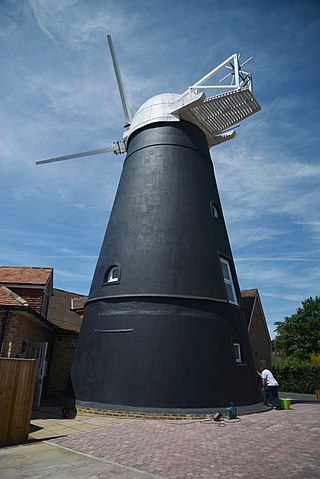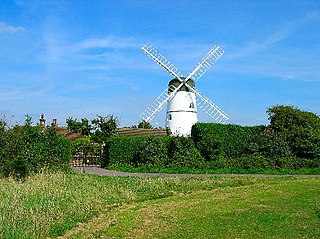
The smock mill is a type of windmill that consists of a sloping, horizontally weatherboarded, thatched, or shingled tower, usually with six or eight sides. It is topped with a roof or cap that rotates to bring the sails into the wind. This type of windmill got its name from its resemblance to smocks worn by farmers in an earlier period.

Clanfield is a village and civil parish in the south-east of the East Hampshire district of Hampshire, England. It is situated 2.4 miles north of Horndean, 12 mi (19 km) north of Portsmouth and 6 mi (10 km) south of Petersfield. It sits to the west of the main A3 road, just north of where the A3(M) (Motorway) ends.

East Hampshire is a constituency represented in the House of Commons of the UK Parliament since 2010 by Damian Hinds of the Conservative Party.

Chalton is a small village and former civil parish, now in the parish of Clanfield, in the East Hampshire district of Hampshire, England. It is 2.3 miles (3.7 km) north-east of Horndean and just east of the A3. The nearest railway station is 3.1 miles (5 km) south of the village, at Rowlands Castle. In 1931 the parish had a population of 158. On 1 April 1932 the parish was abolished and merged with Clanfield, part also went to form Rowlands Castle.

Bursledon Windmill is a Grade II* listed windmill in Bursledon, Hampshire, England which has been restored to working order.

East Runton Windmill is a grade II listed tower mill at East Runton, Norfolk, England which has been converted to residential accommodation.

Cley Windmill is a Grade II* listed tower mill at Cley next the Sea, Norfolk, England which has been converted to hotel accommodation.

Knowle Mill, better known today as Bembridge Windmill, is a Grade I listed, preserved tower mill at Bembridge, Isle of Wight, England.

Oare Mill is a Grade II listed house converted Tower mill in Oare, Kent, England that was built in the late eighteenth or early nineteenth century.

John Baker's Mill is a grade II listed tower mill at Barnham, Sussex, England, which was under restoration and is now to be converted to residential use.

Waterhall Mill, also known as Westdene Windmill, is a grade II listed tower mill at Westdene, Sussex, England which has been converted to residential use.

Stone Cross Windmill is a grade II* listed tower mill at Stone Cross, East Sussex, England which has been restored and is open to the public. The mill was also known as Blackness Mill and the White Mill.

Clavering Windmills are a pair of Grade II listed Tower mills in Clavering, Essex, England. They have both been converted to residential use. They are named North Mill and South Mill. A third mill existed in Clavering until the mid-nineteenth century, known as Clavering Mill.

Crux Easton wind engine is a Grade II listed Titt wind engine, used as a windpump, at Crux Easton, Hampshire, England, which has been restored to working order.

Flixton Road Mill is a tower mill at Bungay, Suffolk, England which has been truncated and converted to residential accommodation. The structure is a Grade II listed building.

Skoulding's Mill is a Grade II listed tower mill at Kelsale, Suffolk, England which has been converted to residential accommodation.

Langstone Windmill is a Grade II listed tower mill at Langstone, Hampshire in England. It has been converted to residential accommodation.
Lannock Mill is a Grade II listed tower mill at Weston, Hertfordshire, England which is derelict.

Windmill Hill is a chalk hill running alongside the A3(M) in the East Hampshire district of Hampshire, England, overlooking Chalton to the east, and Clanfield to the west. It measures 193 metres above sea level and is named so because of Chalton Windmill which sits upon its summit. This windmill is a Grade II listed building which lay derelict until the late 1970s, when it was restored and converted into a private residence.



















